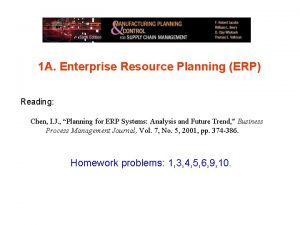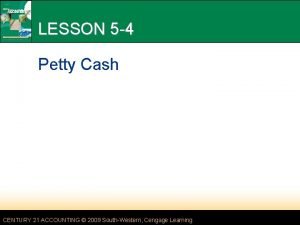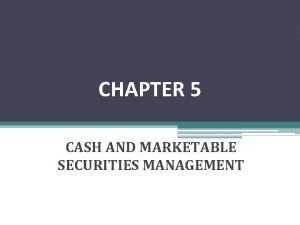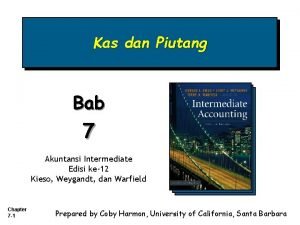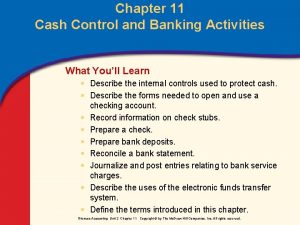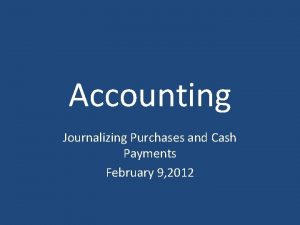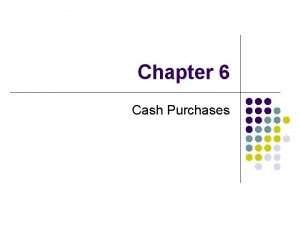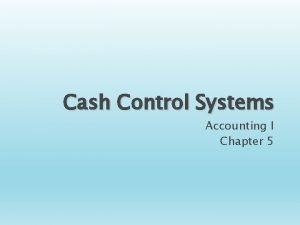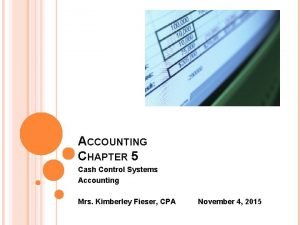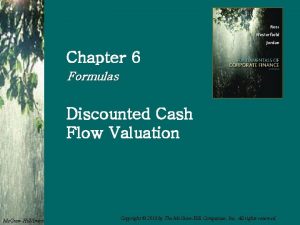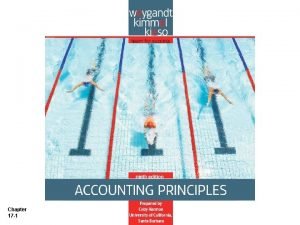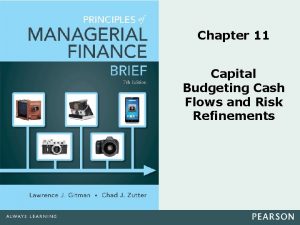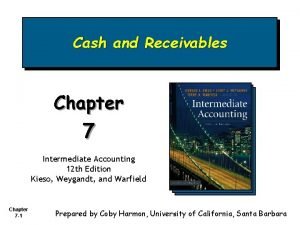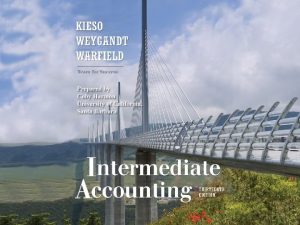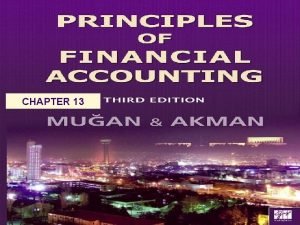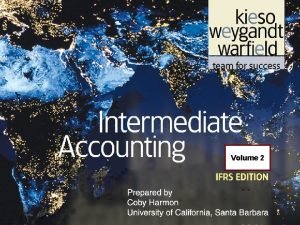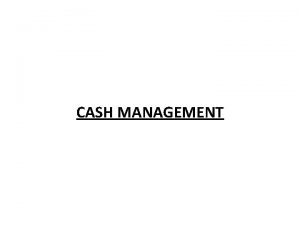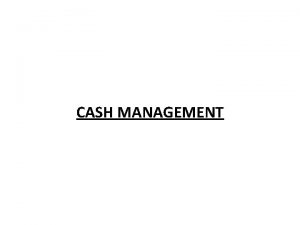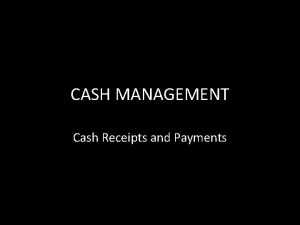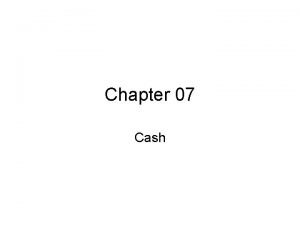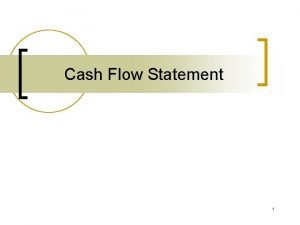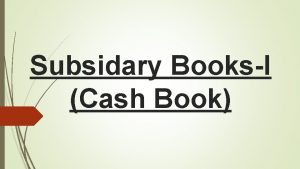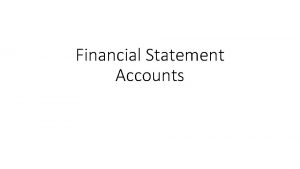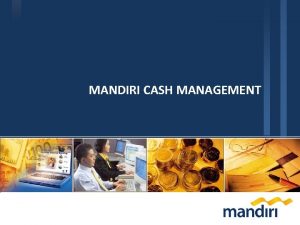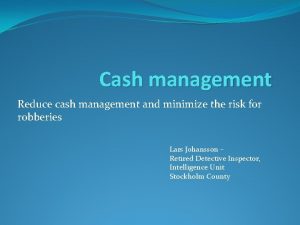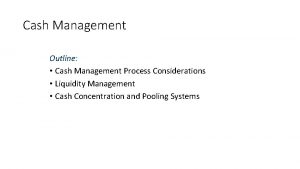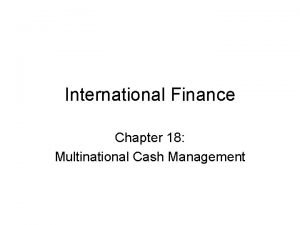Cash Management Chapter 11 Cash Management Cash management




























- Slides: 28

Cash Management Chapter 11

Cash Management • Cash management refers to the management of a hospitality operation’s cash balances, cash flow, and short-term investments in securities. • Cash management is critical to both large and small hospitality operations. • A cash shortfall can quickly lead to bankruptcy.

What Is Considered Cash? In hospitality establishments, cash consists of: • petty cash funds. • cash on hand for operational purposes. • cash in the bank. Some operations also consider time deposits and certificates of deposit to be cash.

Petty Cash Funds • Petty cash funds are established for making minor cash purchases. • These funds are normally maintained on an imprest basis. • That means that they are replenished by the amount of disbursements since the previous replenishment.

House Banks • Cash on hand includes undeposited cash receipts and house banks. • House banks consist of the money kept on hand in order to facilitate cash transactions with guests, such as making change. • Each cash drawer should hold only as much as is needed to transact business. • Added together, the house banks in a hotel may total several thousand dollars. Since house banks do not generate earnings, these cash balances should be minimized.

Demand Deposits • Cash in the bank includes demand deposits. • Ideally, the cash balance in a hospitality operation’s demand deposit bank account should be zero. • However, the cash receipts for a day seldom equal the cash disbursements for the same day. • Therefore, most operations maintain minimum balances in their checking accounts to cover checks drawn. • The reason for keeping these cash balances is commonly referred to as a transaction motive.

The Effective Interest Rate • The size of the checking account balance is influenced by bank policies. • Some banks require depositors to maintain substantial amounts in their accounts to cover bank services and to serve as compensating balances for bank loans. • Since no interest is earned on the compensating balance required under a loan agreement, the effective cost of the loan is higher than its stated interest rate.

Formula for Effective Interest Rate EIR = Annual Interest on Loan – Compensating Balance Requirement

The Opportunity Cost • Aggressive financial managers attempt to keep cash balances as low as possible given in-house cash needs and banking requirements. • The cost of maintaining excessive in-house cash or checking accounts is known as the opportunity cost. • The opportunity cost is the amount of earnings that could have been realized if the excess cash were invested.

The Cash Conversion Cycle • A major objective of cash management is to operate a firm with as little money “invested” in accounts receivables and inventories as possible. • When inventory is sold on account, the investment essentially moves from inventory to accounts receivable. • Within a reasonable time, the business collects these receivables and once again has cash. This process is called the cash conversion cycle. • Generally, the shorter the cycle the better, as this minimizes the amount of cash required to operate the business.

The Operating Cycle • The cash conversion cycle is part of the larger operating cycle that starts with the purchase of inventory on account. • The payables deferral period is the amount of time from the purchase of inventory on account until the business pays the supplier. • The inventory holding period is the amount of time from when inventory is purchased until it is sold. • The accounts receivable collection period (also called the receivables collection period) is the amount of time from the sale on account until the receivables are collected.

Distinction Between Income and Cash Flows • Income flows result from operations generating revenues and incurring expenses. • These flows are shown on the income statement and reflect the results of operations. • Cash flows result from the receipt and disbursement of cash. • It is possible for an operation to generate profits (income flow) yet have a negative cash flow (cash disbursements that exceed cash receipts).

Cash Planning • A business may withstand negative cash flows for short periods if cash reserves are adequate. • Over longer periods, negative cash flows will likely result in failure, even if income flows are positive. • Generally, more cash is required during peak activity periods because cash is tied up in inventories and especially accounts receivable. • Cash planning is intended to ensure that sufficient cash is available at all times. • Cash planning is achieved by preparing cash budgets for several months in the future.

Cash Shortfalls • If a cash budget shows that estimated cash receipts and beginning cash may not cover projected cash disbursements, management must take action. • Even if estimated available cash is greater than projected disbursements, the projected cash balance must provide a sufficient buffer for any cash receipt shortfalls and/or unplanned cash disbursements. • If the estimated cash balance is insufficient, the operation must plan to increase cash receipts, decrease cash disbursements, or do both.

Addressing a Potential Cash Shortfall Management actions to cover temporary deficits may include: • • • obtaining short-term bank loans. obtaining loans from owners. deferring equipment purchases. deferring dividend payments. some combination of these actions.

Factors to Consider When Investing Excess Cash • • • Risk of losing the investment Rate of return Liquidity Brokerage cost Amount of time the funds are to be invested

Approaches to Cash Budgeting There are two basic approaches to cash budgeting: • the cash receipts and disbursements approach • the adjusted net income approach The method chosen depends primarily on the length of time for which the cash budget is prepared.

The Cash Receipts and Disbursements Approach • This approach shows the direct sources of cash receipts (cash sales, collection of accounts receivable, etc. ), and the direct uses of cash (payment of food purchases, payroll, etc. ). • Because this method reflects the direct sources and uses of cash, it is easy to understand. • However, it should generally not be used for periods exceeding 6 months. Projected figures beyond this point become increasingly unreliable, especially when actual operations differ significantly from the operations budget.

The Adjusted Net Income Approach • This approach is generally preferable for budgeting cash for periods longer than 6 months. • This method is an indirect approach to cash budgeting. Much like the SCF prepared on an indirect basis, it focuses on changes in accounts receivable, inventories, and current liabilities. • This approach requires managers to examine working capital accounts and to consider the cash tied up in accounts receivable and inventory and the cash provided by current liabilities.

Information Needed for Cash Budgeting • Estimated percentages of cash and credit sales, along with estimated collections for credit sales • • Estimated other cash receipts Estimated payments for inventory items and payroll The payment schedules for other operating periods Expenses related to property and equipment and a schedule of debt payments • Forecasted dividend payments and forecasted property and equipment and investment purchases

Float • Float is time between the subtraction or addition of cash to the company’s books and the actual subtraction or addition to the company’s bank account. • Payment or disbursement float occurs when a firm writes a check, but there is a delay before the funds are deducted from the bank account. • Collection float occurs when the firm deposits a guest’s check into its bank account. This increases its cash account on the books, but it can’t use the funds until its bank receives funds from the guest’s bank. • The difference between payment float and collection float is called net float. Management ties to increase payment float and decrease

Lockbox System Breakeven Formula B = C / (I × T) where B = Breakeven amount C = Bank charge per item I = Daily interest rate T = Change in time

Monitoring Accounts Receivable • Accounts receivable, especially city ledger accounts, are monitored through ratio analysis and an aging schedule of accounts receivable. • Three useful ratios are accounts receivable to sales, accounts receivable turnover, and number of days accounts receivable outstanding. • An aging of accounts receivable schedule is useful for monitoring delinquent accounts. Maximum efforts should be exerted to collect the oldest accounts. • The aging schedule is also useful for estimating the uncollectible accounts at the end of the accounting period.

Monitoring Inventory • Hospitality firms often must maintain an inventory of food and beverages even though the cost of storing these items is relatively high. • Several costs directly related to inventory include storage, insurance, and personnel. There is also the opportunity cost of tying funds up in inventory. • Management must monitor inventory to keep it as low as possible while still having enough products to meet guest demand. • One ratio used to monitor inventory is inventory turnover, which is calculated by dividing cost of goods used by average inventory cost.

Monitoring Current Liabilities Current liabilities consist primarily of trade payables, taxes payable, accrued wages, and the current portion of longterm debt. The last three are generally paid on stipulated dates, but trade payables require greater attention. • Paying invoices early hurts a firm because the cash used could have been invested until the due date. • In general, management should pay bills only when they are due, unless cash discounts are available for early payment and they lower costs.

Gift Card Breakage • A material amount of gift card sales goes unused. This unused amount is called gift card breakage. • In most cases, gift cards have no expiration dates; while they remain unredeemed, they represent an indefinite obligation. • As time passes, the likelihood of gift card redemption decreases until, at some point, deferred revenue from gift card breakage should be realized and recorded. • It is recommended that the gift card breakage remaining at the end of the fourth year be recorded

Bank Loans Bank loans are a major source of short-term financing. • A promissory note is the traditional bank lending arrangement. The borrower signs a note promising to repay the amount borrowed with interest at a future date. • A line of credit is a relatively informal, nonbinding agreement between bank and borrower that specifies the amount that can be borrowed. They are generally unsecured (that is, not backed by collateral). • A revolving credit agreement is a binding agreement under which the bank guarantees the availability of funds up to a maximum amount during the specified period. It is also

Integrated Cash Management Systems • For multi-unit operations, an integrated cash management system is generally preferable. • This system centralizes cash receipts and especially cash disbursements within the corporate office. • The system’s primary goal is to minimize the amount of cash the operation holds by transferring as much cash as possible to corporate accounts. • This system results in better allocation of funds. • It uses cash forecasting, including the preparation of cash budgets at both the unit and corporate levels.
 Cash to cash cycle time
Cash to cash cycle time Cash to cash cycle time
Cash to cash cycle time Cash in cash out example
Cash in cash out example Budgeted income statement
Budgeted income statement Paid cash to replenish the petty cash fund
Paid cash to replenish the petty cash fund 5-1 on your own p.128 answers accounting
5-1 on your own p.128 answers accounting Marketable securities
Marketable securities Chapter 7 cash and receivables solutions
Chapter 7 cash and receivables solutions Cash and receivables chapter 7 ppt
Cash and receivables chapter 7 ppt Chapter 11 cash control and banking activities
Chapter 11 cash control and banking activities Cash control and banking activities
Cash control and banking activities Special amount column definition
Special amount column definition Chapter 6 cash purchases
Chapter 6 cash purchases Restrictive check endorsement
Restrictive check endorsement Cash control systems
Cash control systems Chapter 6 discounted cash flow valuation
Chapter 6 discounted cash flow valuation Flow chapter 2
Flow chapter 2 Prepaid expenses is
Prepaid expenses is Chapter 11 capital budgeting cash flows solutions
Chapter 11 capital budgeting cash flows solutions Trade receivables examples
Trade receivables examples Cash is current asset or not
Cash is current asset or not Chapter 7 cash and receivables
Chapter 7 cash and receivables Chapter 7 cash and receivables
Chapter 7 cash and receivables Chapter 23 statement of cash flows
Chapter 23 statement of cash flows Chapter 13 statement of cash flows
Chapter 13 statement of cash flows Flow chapter 13
Flow chapter 13 Chapter 23 statement of cash flows
Chapter 23 statement of cash flows Controlsbond
Controlsbond Chapter 7 fraud internal control and cash
Chapter 7 fraud internal control and cash

